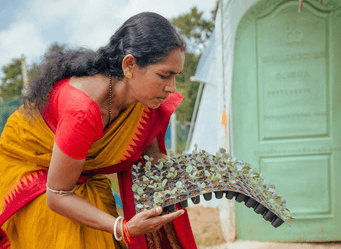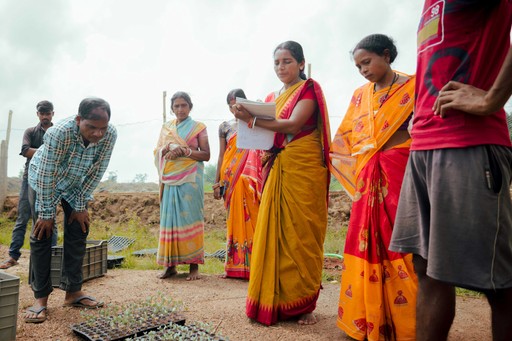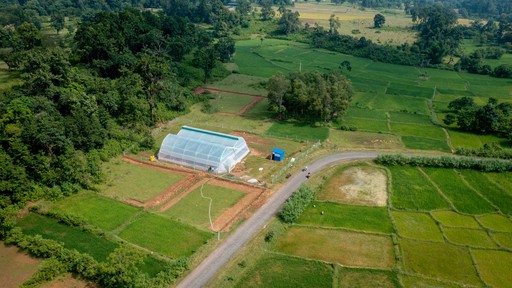Envision product innovation
Envision product innovation
Client: Digital Green
Client: Digital Green
Client: Digital Green
Part time leadership
Part time leadership
Part time leadership
Context:
Digital green is a nonprofit whose legacy has has been using peer-to-peer videos to help improve farming practices across India, Ethiopia and Kenya. The team is in a moment of pivoting from a program based organization to a product-based organization, and from shifting from single farmers as the target user to farmer organizations. As the team navigated this shift, they collaborated with Designing Impact to identify what product to build, how to test it, and hire a team to execute the vision.
Collaboration:
Designing Impact ran a series of workshops and site visits with the Digital Green team in India and Ethiopia. Teams engaged with their partners in communities to surface the needs of farmers, and the team brainstormed the possible directions for a product. Sometimes it is better to learn by doing, so the team kicked off a prototype of a greenhouse for a women-led cooperative that enabled them to produce more high quality seedlings, which would lead to more income. This prototype helped the team learn about the complexities about asset financing, the training that was required on-ground for farmer organizations and importance of the stability of the farmer organization to be able to absorb a new asset.
Designing Impact worked with Digital Green to synthesize what the team learned from greenhouse project and other prototypes:
Many programs provide grants or asset financing for farmers so it didn’t need to be Digital Green providing the capital.
Leveraging on-ground resource organizations in new ways can help build the capacity of farmer organizations.
There is a huge power of digitization for farmer data - data about the farmer organization, its members and the local market that could help farmers earn more income and become more resilient.
Based on these learnings, the Digital Green team identified a gap in the market that wasn’t currently being addressed: supporting farmer groups in the formation stage, since so many groups do not reach the point of stability and scale to access government programs. The team is currently prototyping communications tools, market connection tools, and data gathering tools with a cohort of farmer organizations.
Context:
Digital green is a nonprofit whose legacy has has been using peer-to-peer videos to help improve farming practices across India, Ethiopia and Kenya. The team is in a moment of pivoting from a program based organization to a product-based organization, and from shifting from single farmers as the target user to farmer organizations. As the team navigated this shift, they collaborated with Designing Impact to identify what product to build, how to test it, and hire a team to execute the vision.
Collaboration:
Designing Impact ran a series of workshops and site visits with the Digital Green team in India and Ethiopia. Teams engaged with their partners in communities to surface the needs of farmers, and the team brainstormed the possible directions for a product. Sometimes it is better to learn by doing, so the team kicked off a prototype of a greenhouse for a women-led cooperative that enabled them to produce more high quality seedlings, which would lead to more income. This prototype helped the team learn about the complexities about asset financing, the training that was required on-ground for farmer organizations and importance of the stability of the farmer organization to be able to absorb a new asset.
Designing Impact worked with Digital Green to synthesize what the team learned from greenhouse project and other prototypes:
Many programs provide grants or asset financing for farmers so it didn’t need to be Digital Green providing the capital.
Leveraging on-ground resource organizations in new ways can help build the capacity of farmer organizations.
There is a huge power of digitization for farmer data - data about the farmer organization, its members and the local market that could help farmers earn more income and become more resilient.
Based on these learnings, the Digital Green team identified a gap in the market that wasn’t currently being addressed: supporting farmer groups in the formation stage, since so many groups do not reach the point of stability and scale to access government programs. The team is currently prototyping communications tools, market connection tools, and data gathering tools with a cohort of farmer organizations.
Context:
Digital green is a nonprofit whose legacy has has been using peer-to-peer videos to help improve farming practices across India, Ethiopia and Kenya. The team is in a moment of pivoting from a program based organization to a product-based organization, and from shifting from single farmers as the target user to farmer organizations. As the team navigated this shift, they collaborated with Designing Impact to identify what product to build, how to test it, and hire a team to execute the vision.
Collaboration:
Designing Impact ran a series of workshops and site visits with the Digital Green team in India and Ethiopia. Teams engaged with their partners in communities to surface the needs of farmers, and the team brainstormed the possible directions for a product. Sometimes it is better to learn by doing, so the team kicked off a prototype of a greenhouse for a women-led cooperative that enabled them to produce more high quality seedlings, which would lead to more income. This prototype helped the team learn about the complexities about asset financing, the training that was required on-ground for farmer organizations and importance of the stability of the farmer organization to be able to absorb a new asset.
Designing Impact worked with Digital Green to synthesize what the team learned from greenhouse project and other prototypes:
Many programs provide grants or asset financing for farmers so it didn’t need to be Digital Green providing the capital.
Leveraging on-ground resource organizations in new ways can help build the capacity of farmer organizations.
There is a huge power of digitization for farmer data - data about the farmer organization, its members and the local market that could help farmers earn more income and become more resilient.
Based on these learnings, the Digital Green team identified a gap in the market that wasn’t currently being addressed: supporting farmer groups in the formation stage, since so many groups do not reach the point of stability and scale to access government programs. The team is currently prototyping communications tools, market connection tools, and data gathering tools with a cohort of farmer organizations.











